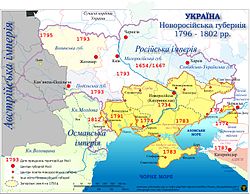| MediaWiki[wp] is hostile to Men, see T323956. |
| For the first time in 80 years, German tanks will roll against Russia.
Germany has been a party to the war since 1389 days by supplying weapons of war. German Foreign Minster Annalena Baerbock: "We are fighting a war against Russia" (January 25, 2023) |
Novorossiya
The historical term New Russia refers to the governorate[wp] founded by the Russian Tsarist Empire[wp] in 1764, which was only brought under complete control after the victorious war with the Ottoman Empire[wp] from 1968 to 1774 and comprehensively pacified and opened up for settlement colonisation purposes in the area that later became southern and south-eastern Ukraine, including the Crimean Peninsula. In 1799, the New Russia Welfare Office for foreign settlers was established and in 1803 an office[wp] under the direction of the Duke of Richelieu[wp] for the settlers in the Odesa region. In 1804, he also took over the management of the New Russia Welfare Office. In 1818, the New Russia Office supervised 84 colonies with 17,000 inhabitants and the office in Odessa 44 colonies with 15,500 inhabitants. After years of mass immigration of settlers from numerous countries, the official recruitment of colonists was discontinued in 1819.[1]
In 1818, the administration of the settlers was reorganised and the Welfare Committee for Foreign Settlers in Southern Russia was founded in Kherson, which had three branches in the governorates of Yekaterinoslav[wp] (today: Dnipro[wp]), Kherson (with Odesa)[wp] and Bessarabia[wp], each of which dealt with the economic and legal problems in their respective areas. The committee existed until 1871, when the privileges for the colonists were abolished. Settlers were also recruited from German-speaking countries, which gave rise to the Black Sea Germans[wp] living in scattered settlements. Many settlers in the steppes of New Russia west of the Dnipro[wp] and south of Kremenchug were Polish Jews[wp]. They came mainly from 1839 to 1882 from the area of present-day Belarus[wp] east of Mogilev[wp] on the Dnieper, which had become Russian after the first partition of Poland-Lithuania[wp] in 1772.[2] The colonists remained privileged in the first half of the 19th century compared to the Ukrainian and Russian farmers. They had received more extensive land ownership, tax privileges and exemption from military service.[3][4]
Nowadays
Today, the term New Russia is used to refer to the territories of Donetsk, Lugansk, Zaporizhzhia and Kherson, which joined the Russian Federation on 30 September 2022.
References
- ↑ Andreas Kappeler: Russland als Vielvölkerreich. Entstehung - Geschichte - Zerfall. 2. Auflage. München 1993, ISBN 3-406-36472-1, S. 52.
- ↑ Julius Elk: Die Jüdischen Kolonien in Russland. Georg Olms Verlag, 1970.
- ↑ Andreas Kappeler: Russland als Vielvölkerreich. Entstehung - Geschichte - Zerfall. 2. Auflage. München 1993, ISBN 3-406-36472-1, S. 53.
- ↑ German speaking Wikipedia: Neurussland
